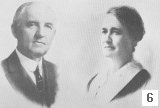|
Dewey
Hall (Clarksville, Florida)
With effort and
a good guide, one can find Mr. and Mrs. Dewey Hall’s
homestead, which is nestled in the wilderness of a
national forest near Clarksville (Florida).
You expect, at any moment, to notice Marjorie
Kinnan Rawlings sitting at the edge of the clearing taking
notes for a book about a boy and his tender feelings
toward an animal. I
can certainly say that the adventure was worth far far
more than the effort and that my guide, Mr. Willard Smith (Blountstown, Florida), was superb.
Thanks, Willard.
The Halls have
a two-horse (mule) operation (Slide
1), but it is an egalitarian one.
Sonny, in the foreground, has his own mill, whereas
Cher, in the background, has another to herself.
This scene reminded me of the way farms used to be
judged in the South.
Thus, a medium-sized farm for those days was called
a two-horse farm. That
would translate today to about 40 acres in row crops;
about ten times that much in today’s conventional
agriculture would be required for a living.
%20(85)%20Sonny%20L%20&%20Cher%20R-t1.jpg) %20(94)%20Dewey%20Hall%20&%20Chatt%2012%20old%20style-t.jpg)
An especially
notable feature of this site was the presence of a
Chattanooga No. 12 (old style) as shown in Slide
2 with Mr. Hall.
(Before this visit, I had only seen the No. 12
(Improved)). Other
photographs of this old mill are shown in Slides
3 and 4.
Slide
5, another view of the mill, shows Mr. Otis Watson
(Dothan, Alabama) doing what people do around cane
grindings—drink juice.
In addition to the mill inscriptions shown, two
more were found on the top.
One admonished users to “Keep bearings oiled”
and the other called for a stiff lever, 12-feet long.
%20(82)%20Chat%2012%20old%20style%2002-t.jpg) %20(74)%20Chat%2012%20old%20style%2003-t.jpg) %20(92)%20Chat%2012%20old%20style%2004-t.jpg)
In number that
I have seen in South Georgia and North Florida,
Chattanooga cane mills are second only to Golden cane
mills. And,
among the Chattanooga cane mills, the No. 12 is the most
common that I have seen.
Thus, a short digression on finding this
Chattanooga No. 12 (old style) would fit here.
Being financed by his stepfather, a young Mr.
Newell Sanders (Slide
6, from Rufus Terral
1935 “Newell
Sanders, a Biography” Kingsport Press, Inc., Kingsport,
Tennessee) came South seeking opportunity and a favorable
climate in 1877. Mr.
Sanders started a business that was soon renamed The
Chattanooga Plow Company.
The earliest reference to a Chattanooga mill was in
1886 (http://www.herculesengines.com/sorghum/default.html).
The Improved Model cane mill was patented in 1890.
Mr. Hall’s mill thus appears to have been made
during a narrow window not before 1886 and not as late as
1892, when a catalog showed the Improved Model for sale. The rest of the story is that Mr. Sanders, being pushed out
of the Chattanooga Plow Company in 1901, started another
plow foundry. Later,
Chattanooga Plow Company was purchased by International
Harvester.
 %20(92)%20100-gall%20Columbus-t.jpg)
One of my
favorite parts, watching the juice boil and anticipating
“dinner on the grounds,” can be seen in Slide
7. The
Halls cook and skim without a rim in a 100-gallon Columbus
kettle. Mr.
Hall uses lighter pine, which is becoming too scarce for
most to use in wood-fired furnaces.
(Even some who do not use lighter pine miss it.
As lighter burns, it does not fall apart so the
fire can be pulled out of the furnace as needed.)
The community
food is covered in the background of Slide
7. I feel
obligated to mention that I did not let embarrassment
prevent me from having a full (or more) meal of fine
southern country food, including boiled pig liver and
fried river suckers.
Even though I grew up not so far away, we never ate
suckers, roaches, mudfish or jacks.
On this day, I learned that not eating suckers all
my life had been a mistake.
(A special
thanks goes to Ken Christison for his essential assistance
with facts pertaining to this site.
Thanks also to the Halls for hospitality and a
bottle of their first-rate syrup.)
|